Developing Market Share: A Strategic Proposal for Cost Reduction
VerifiedAdded on 2023/04/21
|12
|1992
|250
Report
AI Summary
This report proposes strategies for XYZ Company to develop market share while reducing costs. It assesses market segmentation (geographic, demographic, behavioral, and psychographic), distribution channels (analyzing customer needs and evaluating alternatives), and logistics (warehousing, inventory control, transportation, and order processing). The report also emphasizes supply chain management for improved customer service, reduced operational costs, and enhanced financial positioning. Market research tools like Google Keywords Tool, surveys, and interviews are suggested for understanding consumer behavior and market dynamics. The goal is to provide a comprehensive approach to marketing and production strategies for the organization.
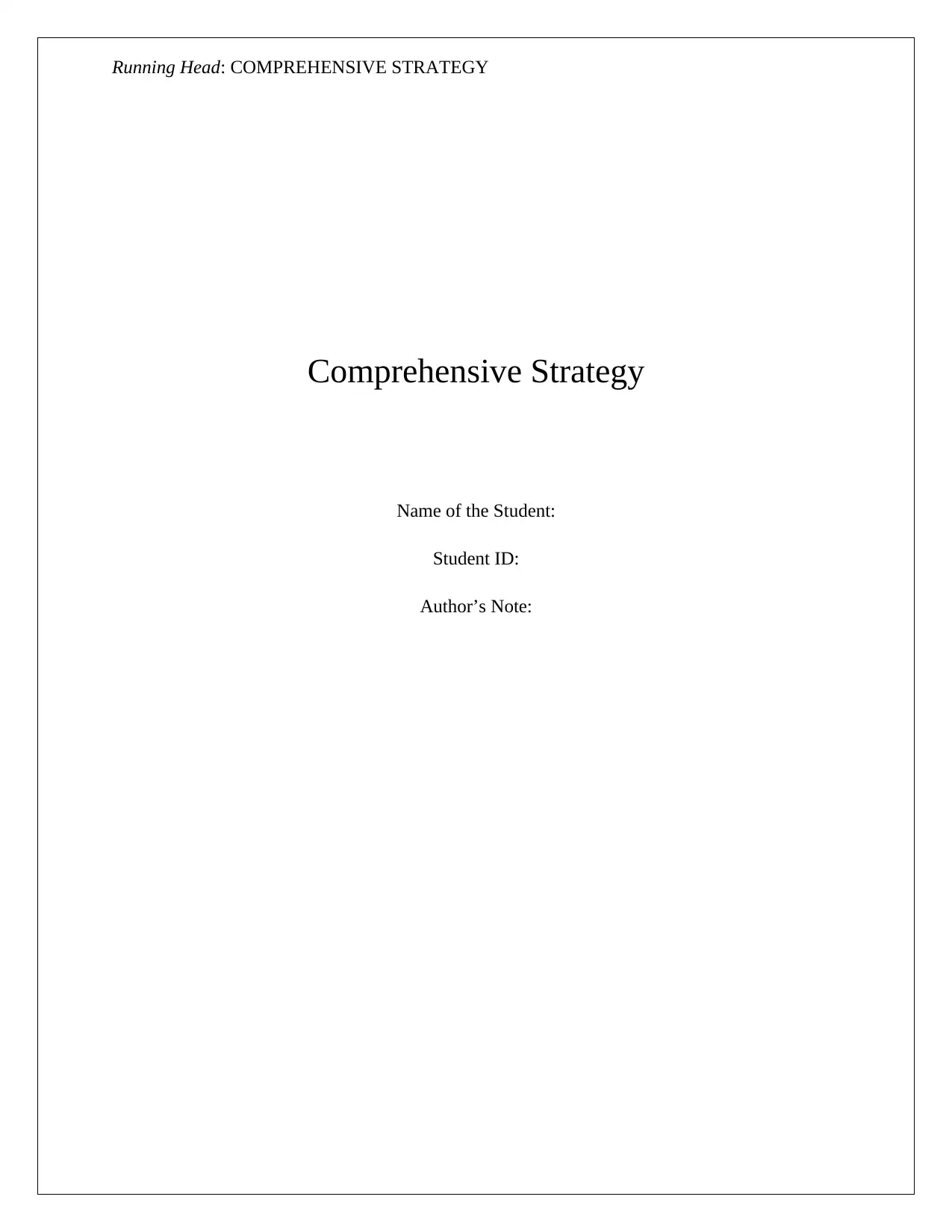
Running Head: COMPREHENSIVE STRATEGY
Comprehensive Strategy
Name of the Student:
Student ID:
Author’s Note:
Comprehensive Strategy
Name of the Student:
Student ID:
Author’s Note:
Paraphrase This Document
Need a fresh take? Get an instant paraphrase of this document with our AI Paraphraser
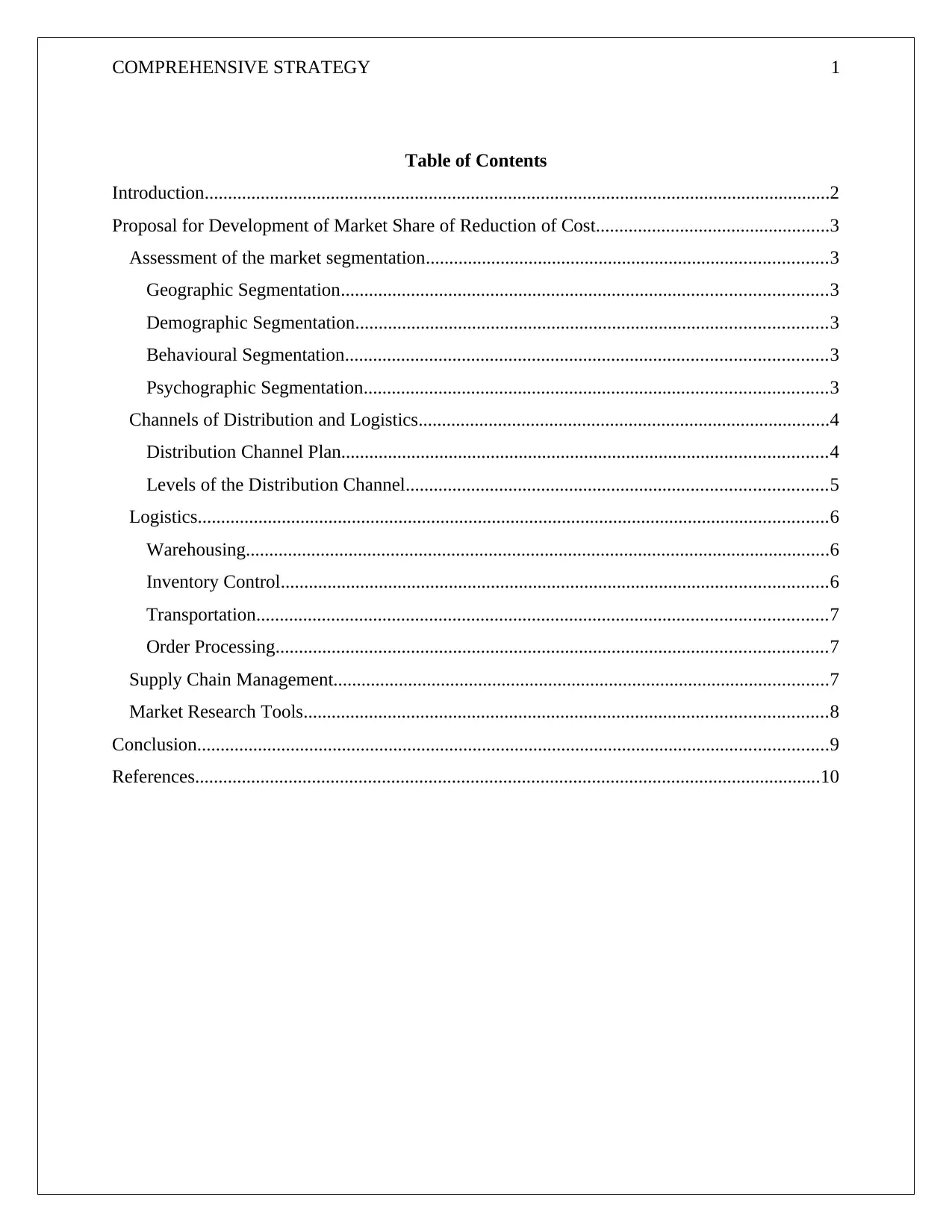
COMPREHENSIVE STRATEGY 1
Table of Contents
Introduction......................................................................................................................................2
Proposal for Development of Market Share of Reduction of Cost..................................................3
Assessment of the market segmentation......................................................................................3
Geographic Segmentation........................................................................................................3
Demographic Segmentation.....................................................................................................3
Behavioural Segmentation.......................................................................................................3
Psychographic Segmentation...................................................................................................3
Channels of Distribution and Logistics........................................................................................4
Distribution Channel Plan........................................................................................................4
Levels of the Distribution Channel..........................................................................................5
Logistics.......................................................................................................................................6
Warehousing.............................................................................................................................6
Inventory Control.....................................................................................................................6
Transportation..........................................................................................................................7
Order Processing......................................................................................................................7
Supply Chain Management..........................................................................................................7
Market Research Tools................................................................................................................8
Conclusion.......................................................................................................................................9
References......................................................................................................................................10
Table of Contents
Introduction......................................................................................................................................2
Proposal for Development of Market Share of Reduction of Cost..................................................3
Assessment of the market segmentation......................................................................................3
Geographic Segmentation........................................................................................................3
Demographic Segmentation.....................................................................................................3
Behavioural Segmentation.......................................................................................................3
Psychographic Segmentation...................................................................................................3
Channels of Distribution and Logistics........................................................................................4
Distribution Channel Plan........................................................................................................4
Levels of the Distribution Channel..........................................................................................5
Logistics.......................................................................................................................................6
Warehousing.............................................................................................................................6
Inventory Control.....................................................................................................................6
Transportation..........................................................................................................................7
Order Processing......................................................................................................................7
Supply Chain Management..........................................................................................................7
Market Research Tools................................................................................................................8
Conclusion.......................................................................................................................................9
References......................................................................................................................................10
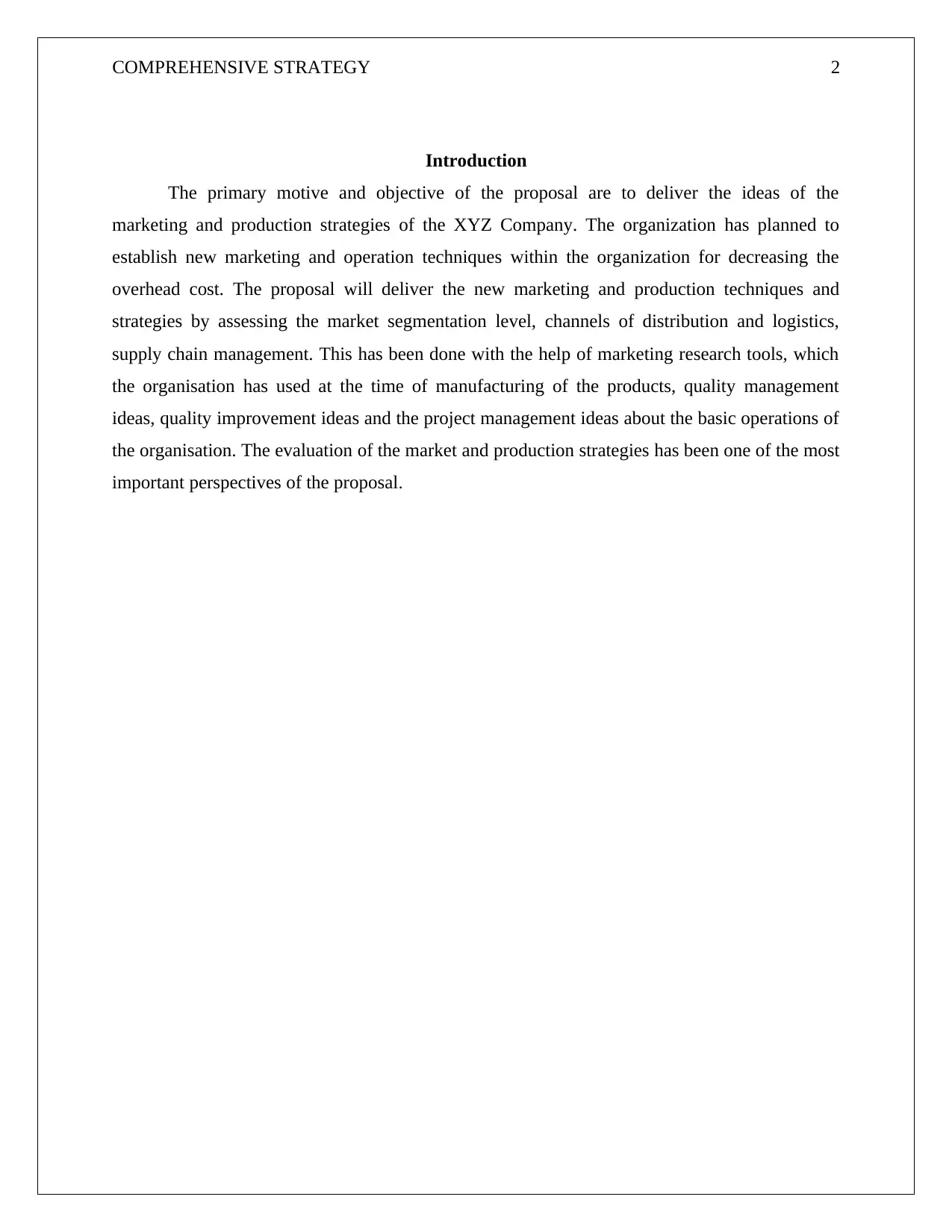
COMPREHENSIVE STRATEGY 2
Introduction
The primary motive and objective of the proposal are to deliver the ideas of the
marketing and production strategies of the XYZ Company. The organization has planned to
establish new marketing and operation techniques within the organization for decreasing the
overhead cost. The proposal will deliver the new marketing and production techniques and
strategies by assessing the market segmentation level, channels of distribution and logistics,
supply chain management. This has been done with the help of marketing research tools, which
the organisation has used at the time of manufacturing of the products, quality management
ideas, quality improvement ideas and the project management ideas about the basic operations of
the organisation. The evaluation of the market and production strategies has been one of the most
important perspectives of the proposal.
Introduction
The primary motive and objective of the proposal are to deliver the ideas of the
marketing and production strategies of the XYZ Company. The organization has planned to
establish new marketing and operation techniques within the organization for decreasing the
overhead cost. The proposal will deliver the new marketing and production techniques and
strategies by assessing the market segmentation level, channels of distribution and logistics,
supply chain management. This has been done with the help of marketing research tools, which
the organisation has used at the time of manufacturing of the products, quality management
ideas, quality improvement ideas and the project management ideas about the basic operations of
the organisation. The evaluation of the market and production strategies has been one of the most
important perspectives of the proposal.
⊘ This is a preview!⊘
Do you want full access?
Subscribe today to unlock all pages.

Trusted by 1+ million students worldwide
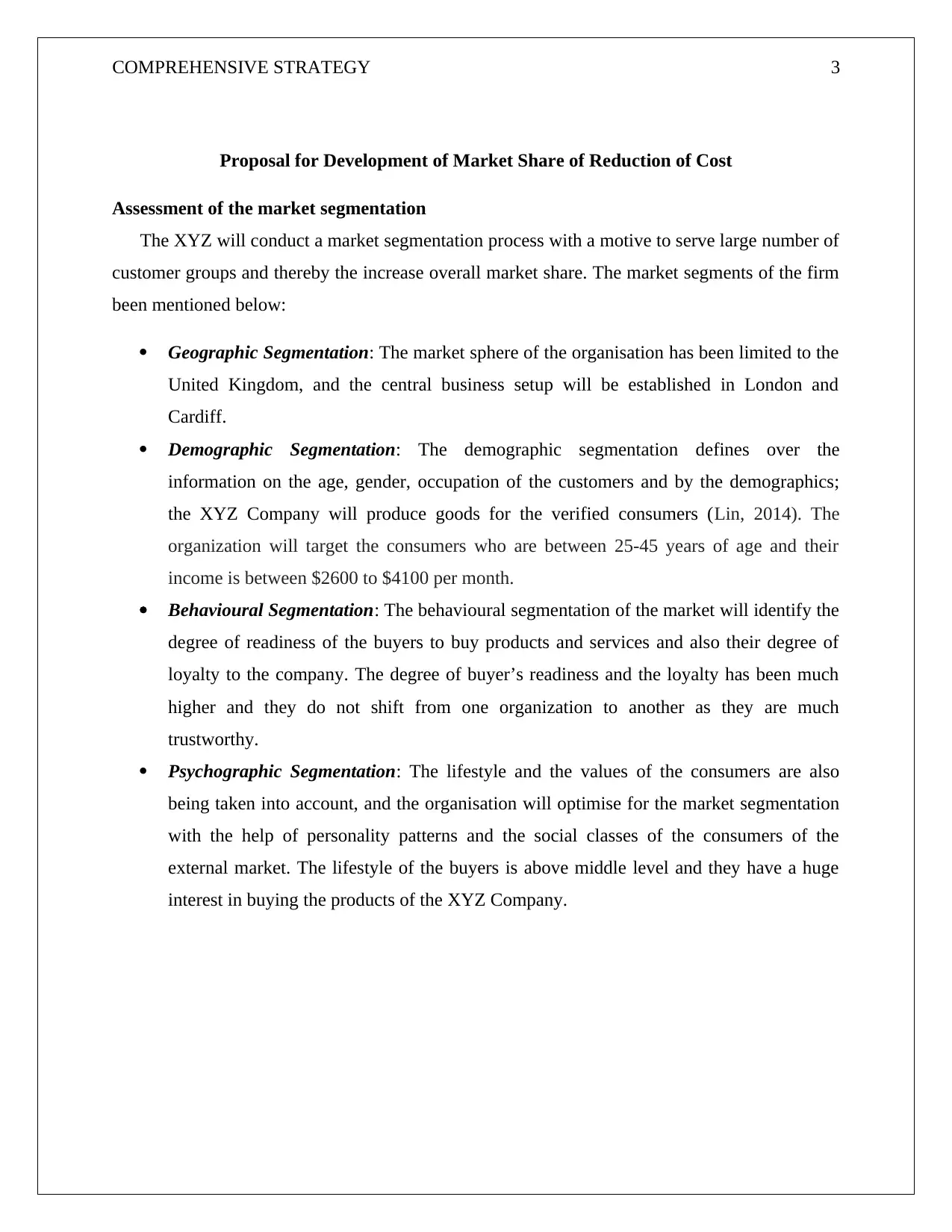
COMPREHENSIVE STRATEGY 3
Proposal for Development of Market Share of Reduction of Cost
Assessment of the market segmentation
The XYZ will conduct a market segmentation process with a motive to serve large number of
customer groups and thereby the increase overall market share. The market segments of the firm
been mentioned below:
Geographic Segmentation: The market sphere of the organisation has been limited to the
United Kingdom, and the central business setup will be established in London and
Cardiff.
Demographic Segmentation: The demographic segmentation defines over the
information on the age, gender, occupation of the customers and by the demographics;
the XYZ Company will produce goods for the verified consumers (Lin, 2014). The
organization will target the consumers who are between 25-45 years of age and their
income is between $2600 to $4100 per month.
Behavioural Segmentation: The behavioural segmentation of the market will identify the
degree of readiness of the buyers to buy products and services and also their degree of
loyalty to the company. The degree of buyer’s readiness and the loyalty has been much
higher and they do not shift from one organization to another as they are much
trustworthy.
Psychographic Segmentation: The lifestyle and the values of the consumers are also
being taken into account, and the organisation will optimise for the market segmentation
with the help of personality patterns and the social classes of the consumers of the
external market. The lifestyle of the buyers is above middle level and they have a huge
interest in buying the products of the XYZ Company.
Proposal for Development of Market Share of Reduction of Cost
Assessment of the market segmentation
The XYZ will conduct a market segmentation process with a motive to serve large number of
customer groups and thereby the increase overall market share. The market segments of the firm
been mentioned below:
Geographic Segmentation: The market sphere of the organisation has been limited to the
United Kingdom, and the central business setup will be established in London and
Cardiff.
Demographic Segmentation: The demographic segmentation defines over the
information on the age, gender, occupation of the customers and by the demographics;
the XYZ Company will produce goods for the verified consumers (Lin, 2014). The
organization will target the consumers who are between 25-45 years of age and their
income is between $2600 to $4100 per month.
Behavioural Segmentation: The behavioural segmentation of the market will identify the
degree of readiness of the buyers to buy products and services and also their degree of
loyalty to the company. The degree of buyer’s readiness and the loyalty has been much
higher and they do not shift from one organization to another as they are much
trustworthy.
Psychographic Segmentation: The lifestyle and the values of the consumers are also
being taken into account, and the organisation will optimise for the market segmentation
with the help of personality patterns and the social classes of the consumers of the
external market. The lifestyle of the buyers is above middle level and they have a huge
interest in buying the products of the XYZ Company.
Paraphrase This Document
Need a fresh take? Get an instant paraphrase of this document with our AI Paraphraser
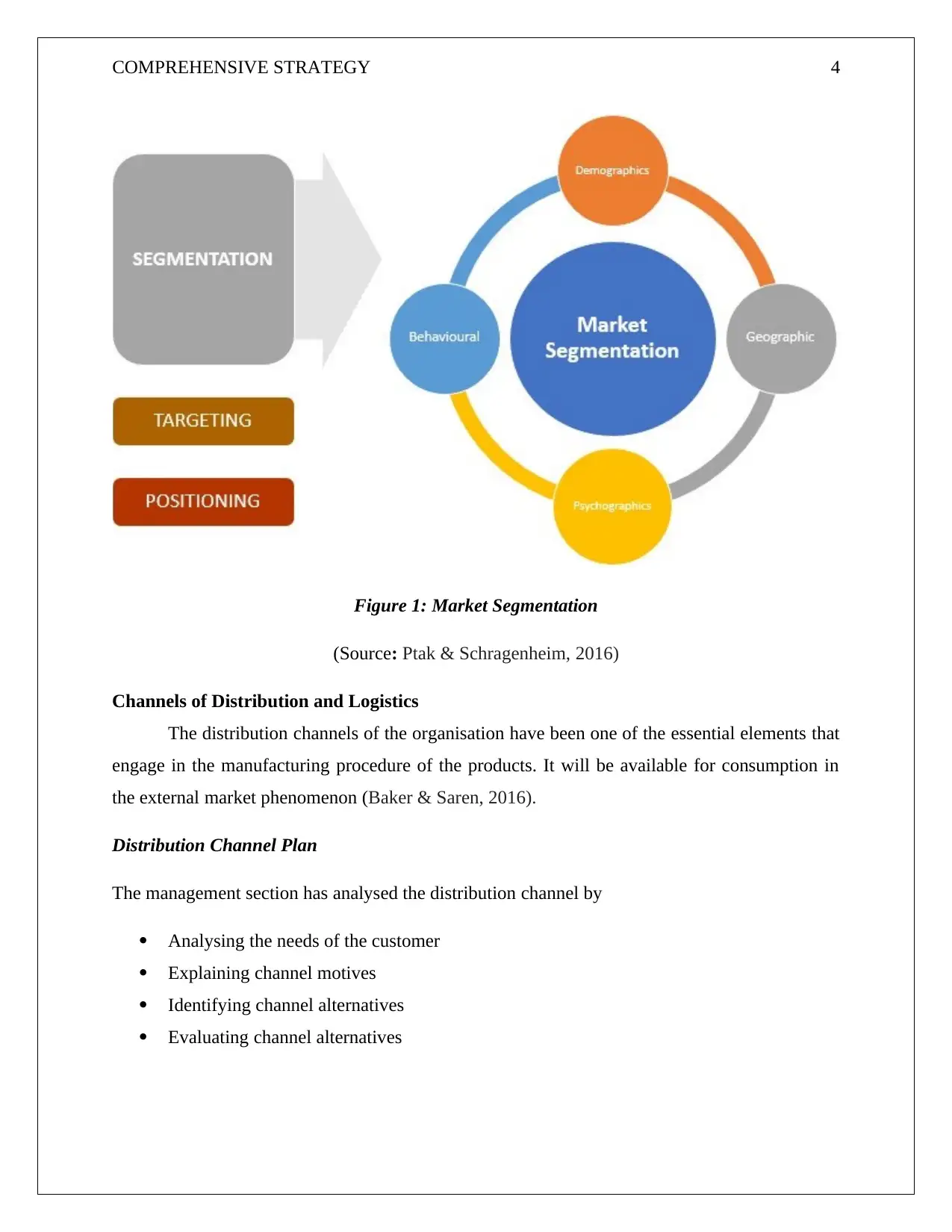
COMPREHENSIVE STRATEGY 4
Figure 1: Market Segmentation
(Source: Ptak & Schragenheim, 2016)
Channels of Distribution and Logistics
The distribution channels of the organisation have been one of the essential elements that
engage in the manufacturing procedure of the products. It will be available for consumption in
the external market phenomenon (Baker & Saren, 2016).
Distribution Channel Plan
The management section has analysed the distribution channel by
Analysing the needs of the customer
Explaining channel motives
Identifying channel alternatives
Evaluating channel alternatives
Figure 1: Market Segmentation
(Source: Ptak & Schragenheim, 2016)
Channels of Distribution and Logistics
The distribution channels of the organisation have been one of the essential elements that
engage in the manufacturing procedure of the products. It will be available for consumption in
the external market phenomenon (Baker & Saren, 2016).
Distribution Channel Plan
The management section has analysed the distribution channel by
Analysing the needs of the customer
Explaining channel motives
Identifying channel alternatives
Evaluating channel alternatives
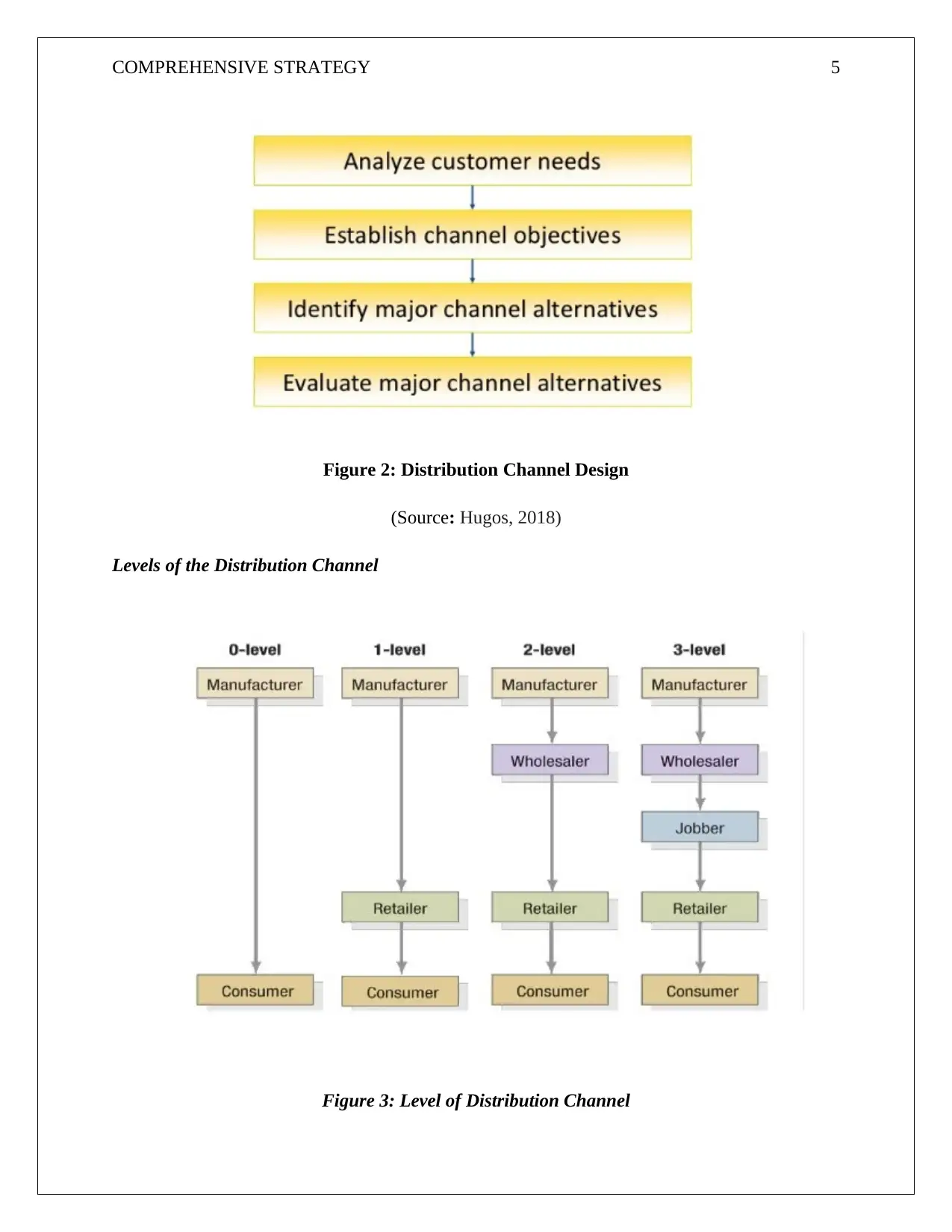
COMPREHENSIVE STRATEGY 5
Figure 2: Distribution Channel Design
(Source: Hugos, 2018)
Levels of the Distribution Channel
Figure 3: Level of Distribution Channel
Figure 2: Distribution Channel Design
(Source: Hugos, 2018)
Levels of the Distribution Channel
Figure 3: Level of Distribution Channel
⊘ This is a preview!⊘
Do you want full access?
Subscribe today to unlock all pages.

Trusted by 1+ million students worldwide
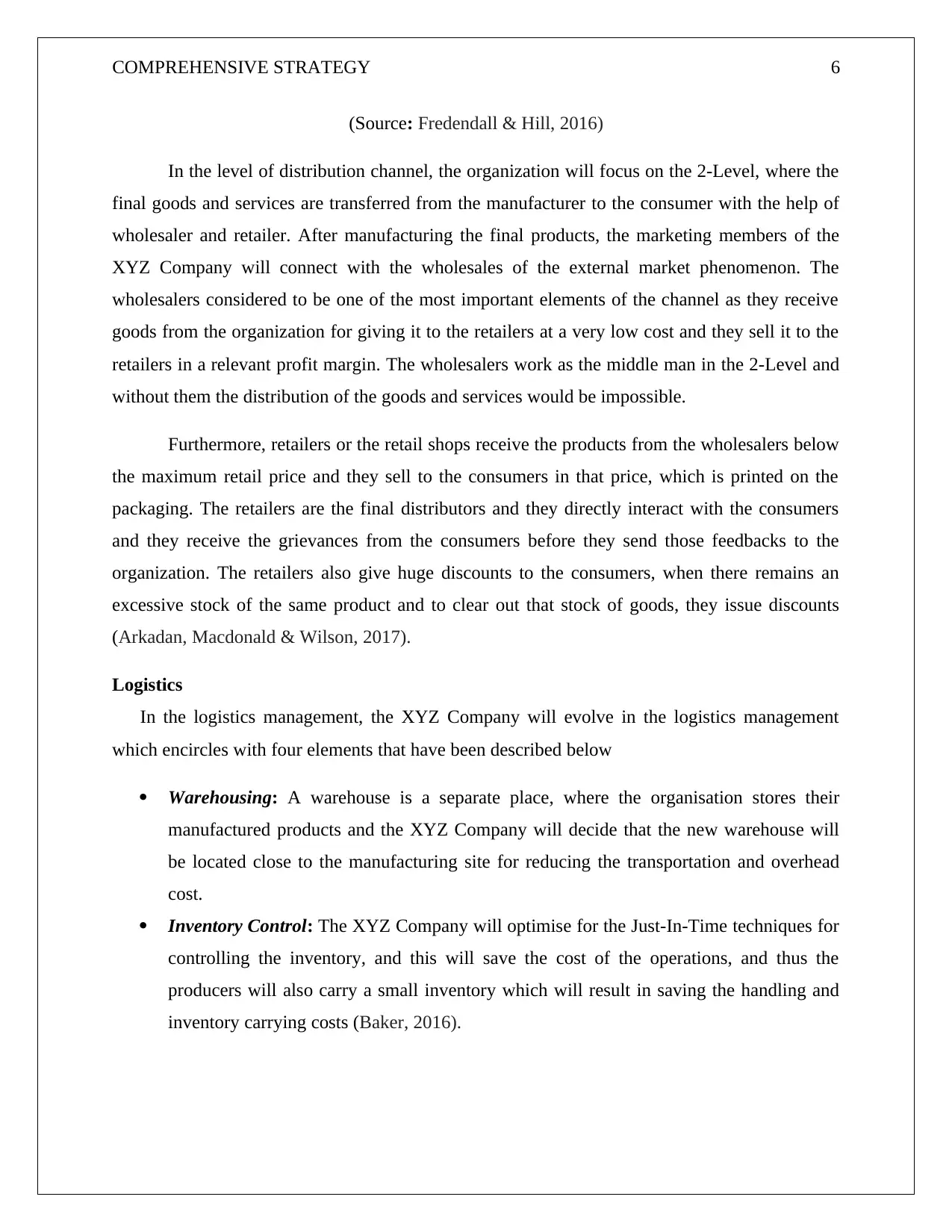
COMPREHENSIVE STRATEGY 6
(Source: Fredendall & Hill, 2016)
In the level of distribution channel, the organization will focus on the 2-Level, where the
final goods and services are transferred from the manufacturer to the consumer with the help of
wholesaler and retailer. After manufacturing the final products, the marketing members of the
XYZ Company will connect with the wholesales of the external market phenomenon. The
wholesalers considered to be one of the most important elements of the channel as they receive
goods from the organization for giving it to the retailers at a very low cost and they sell it to the
retailers in a relevant profit margin. The wholesalers work as the middle man in the 2-Level and
without them the distribution of the goods and services would be impossible.
Furthermore, retailers or the retail shops receive the products from the wholesalers below
the maximum retail price and they sell to the consumers in that price, which is printed on the
packaging. The retailers are the final distributors and they directly interact with the consumers
and they receive the grievances from the consumers before they send those feedbacks to the
organization. The retailers also give huge discounts to the consumers, when there remains an
excessive stock of the same product and to clear out that stock of goods, they issue discounts
(Arkadan, Macdonald & Wilson, 2017).
Logistics
In the logistics management, the XYZ Company will evolve in the logistics management
which encircles with four elements that have been described below
Warehousing: A warehouse is a separate place, where the organisation stores their
manufactured products and the XYZ Company will decide that the new warehouse will
be located close to the manufacturing site for reducing the transportation and overhead
cost.
Inventory Control: The XYZ Company will optimise for the Just-In-Time techniques for
controlling the inventory, and this will save the cost of the operations, and thus the
producers will also carry a small inventory which will result in saving the handling and
inventory carrying costs (Baker, 2016).
(Source: Fredendall & Hill, 2016)
In the level of distribution channel, the organization will focus on the 2-Level, where the
final goods and services are transferred from the manufacturer to the consumer with the help of
wholesaler and retailer. After manufacturing the final products, the marketing members of the
XYZ Company will connect with the wholesales of the external market phenomenon. The
wholesalers considered to be one of the most important elements of the channel as they receive
goods from the organization for giving it to the retailers at a very low cost and they sell it to the
retailers in a relevant profit margin. The wholesalers work as the middle man in the 2-Level and
without them the distribution of the goods and services would be impossible.
Furthermore, retailers or the retail shops receive the products from the wholesalers below
the maximum retail price and they sell to the consumers in that price, which is printed on the
packaging. The retailers are the final distributors and they directly interact with the consumers
and they receive the grievances from the consumers before they send those feedbacks to the
organization. The retailers also give huge discounts to the consumers, when there remains an
excessive stock of the same product and to clear out that stock of goods, they issue discounts
(Arkadan, Macdonald & Wilson, 2017).
Logistics
In the logistics management, the XYZ Company will evolve in the logistics management
which encircles with four elements that have been described below
Warehousing: A warehouse is a separate place, where the organisation stores their
manufactured products and the XYZ Company will decide that the new warehouse will
be located close to the manufacturing site for reducing the transportation and overhead
cost.
Inventory Control: The XYZ Company will optimise for the Just-In-Time techniques for
controlling the inventory, and this will save the cost of the operations, and thus the
producers will also carry a small inventory which will result in saving the handling and
inventory carrying costs (Baker, 2016).
Paraphrase This Document
Need a fresh take? Get an instant paraphrase of this document with our AI Paraphraser
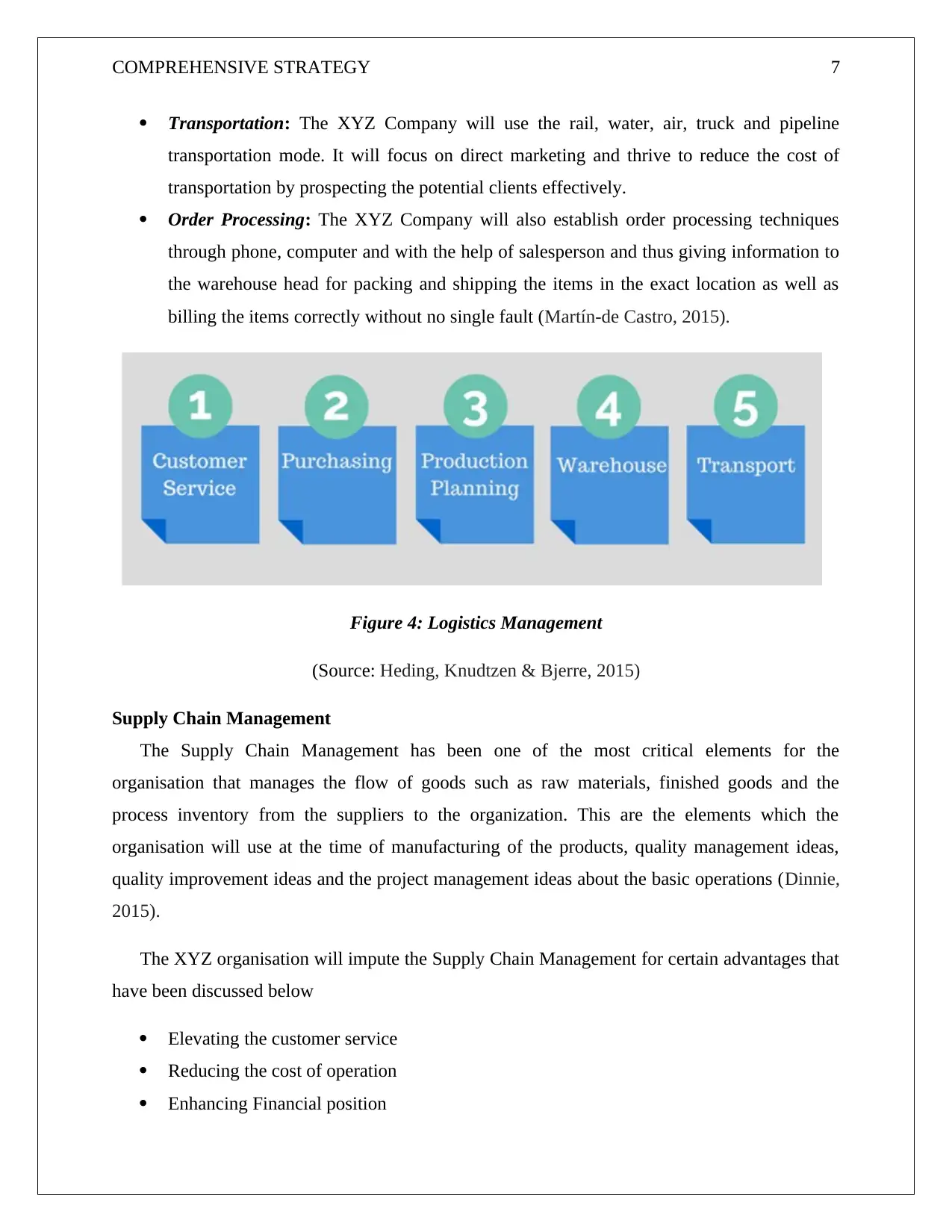
COMPREHENSIVE STRATEGY 7
Transportation: The XYZ Company will use the rail, water, air, truck and pipeline
transportation mode. It will focus on direct marketing and thrive to reduce the cost of
transportation by prospecting the potential clients effectively.
Order Processing: The XYZ Company will also establish order processing techniques
through phone, computer and with the help of salesperson and thus giving information to
the warehouse head for packing and shipping the items in the exact location as well as
billing the items correctly without no single fault (Martín-de Castro, 2015).
Figure 4: Logistics Management
(Source: Heding, Knudtzen & Bjerre, 2015)
Supply Chain Management
The Supply Chain Management has been one of the most critical elements for the
organisation that manages the flow of goods such as raw materials, finished goods and the
process inventory from the suppliers to the organization. This are the elements which the
organisation will use at the time of manufacturing of the products, quality management ideas,
quality improvement ideas and the project management ideas about the basic operations (Dinnie,
2015).
The XYZ organisation will impute the Supply Chain Management for certain advantages that
have been discussed below
Elevating the customer service
Reducing the cost of operation
Enhancing Financial position
Transportation: The XYZ Company will use the rail, water, air, truck and pipeline
transportation mode. It will focus on direct marketing and thrive to reduce the cost of
transportation by prospecting the potential clients effectively.
Order Processing: The XYZ Company will also establish order processing techniques
through phone, computer and with the help of salesperson and thus giving information to
the warehouse head for packing and shipping the items in the exact location as well as
billing the items correctly without no single fault (Martín-de Castro, 2015).
Figure 4: Logistics Management
(Source: Heding, Knudtzen & Bjerre, 2015)
Supply Chain Management
The Supply Chain Management has been one of the most critical elements for the
organisation that manages the flow of goods such as raw materials, finished goods and the
process inventory from the suppliers to the organization. This are the elements which the
organisation will use at the time of manufacturing of the products, quality management ideas,
quality improvement ideas and the project management ideas about the basic operations (Dinnie,
2015).
The XYZ organisation will impute the Supply Chain Management for certain advantages that
have been discussed below
Elevating the customer service
Reducing the cost of operation
Enhancing Financial position
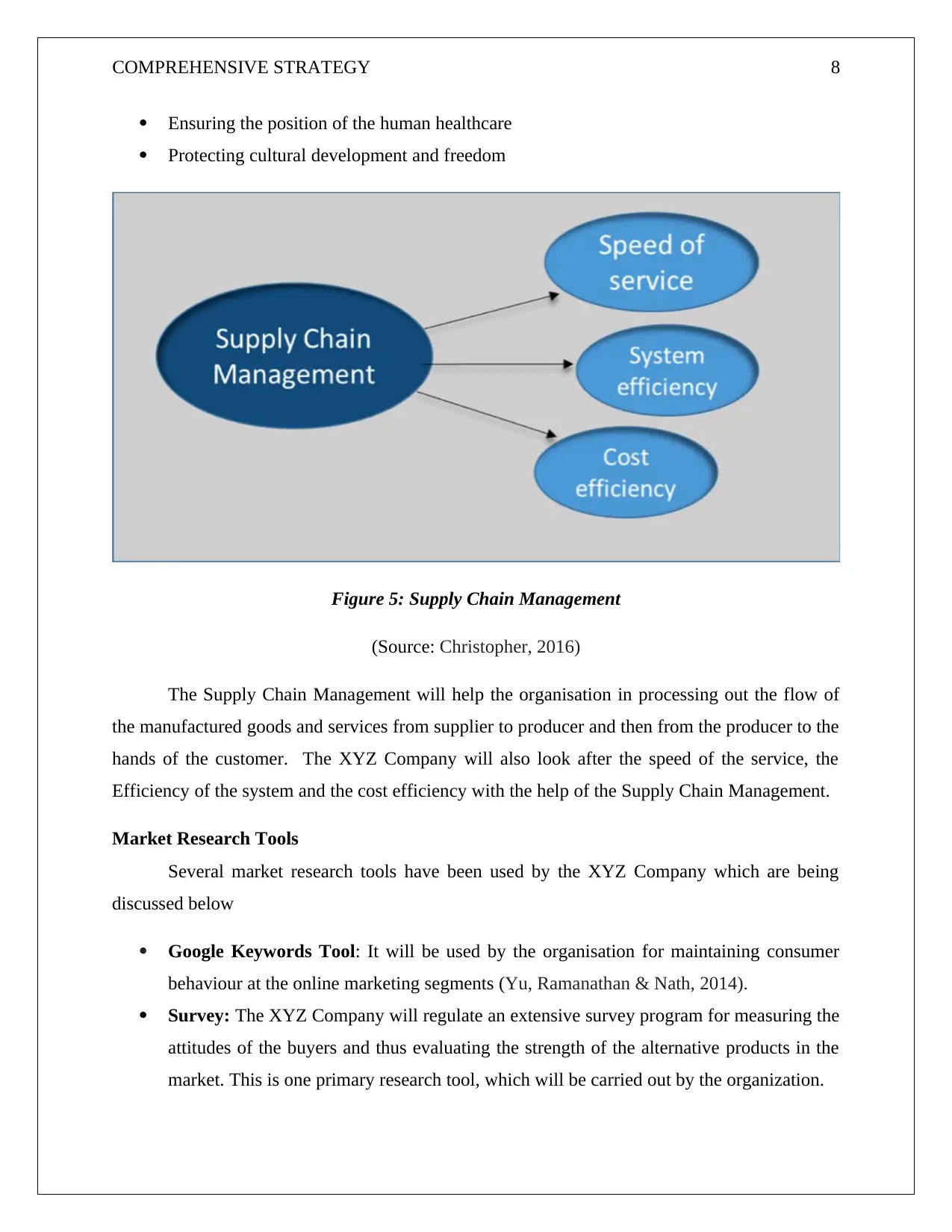
COMPREHENSIVE STRATEGY 8
Ensuring the position of the human healthcare
Protecting cultural development and freedom
Figure 5: Supply Chain Management
(Source: Christopher, 2016)
The Supply Chain Management will help the organisation in processing out the flow of
the manufactured goods and services from supplier to producer and then from the producer to the
hands of the customer. The XYZ Company will also look after the speed of the service, the
Efficiency of the system and the cost efficiency with the help of the Supply Chain Management.
Market Research Tools
Several market research tools have been used by the XYZ Company which are being
discussed below
Google Keywords Tool: It will be used by the organisation for maintaining consumer
behaviour at the online marketing segments (Yu, Ramanathan & Nath, 2014).
Survey: The XYZ Company will regulate an extensive survey program for measuring the
attitudes of the buyers and thus evaluating the strength of the alternative products in the
market. This is one primary research tool, which will be carried out by the organization.
Ensuring the position of the human healthcare
Protecting cultural development and freedom
Figure 5: Supply Chain Management
(Source: Christopher, 2016)
The Supply Chain Management will help the organisation in processing out the flow of
the manufactured goods and services from supplier to producer and then from the producer to the
hands of the customer. The XYZ Company will also look after the speed of the service, the
Efficiency of the system and the cost efficiency with the help of the Supply Chain Management.
Market Research Tools
Several market research tools have been used by the XYZ Company which are being
discussed below
Google Keywords Tool: It will be used by the organisation for maintaining consumer
behaviour at the online marketing segments (Yu, Ramanathan & Nath, 2014).
Survey: The XYZ Company will regulate an extensive survey program for measuring the
attitudes of the buyers and thus evaluating the strength of the alternative products in the
market. This is one primary research tool, which will be carried out by the organization.
⊘ This is a preview!⊘
Do you want full access?
Subscribe today to unlock all pages.

Trusted by 1+ million students worldwide
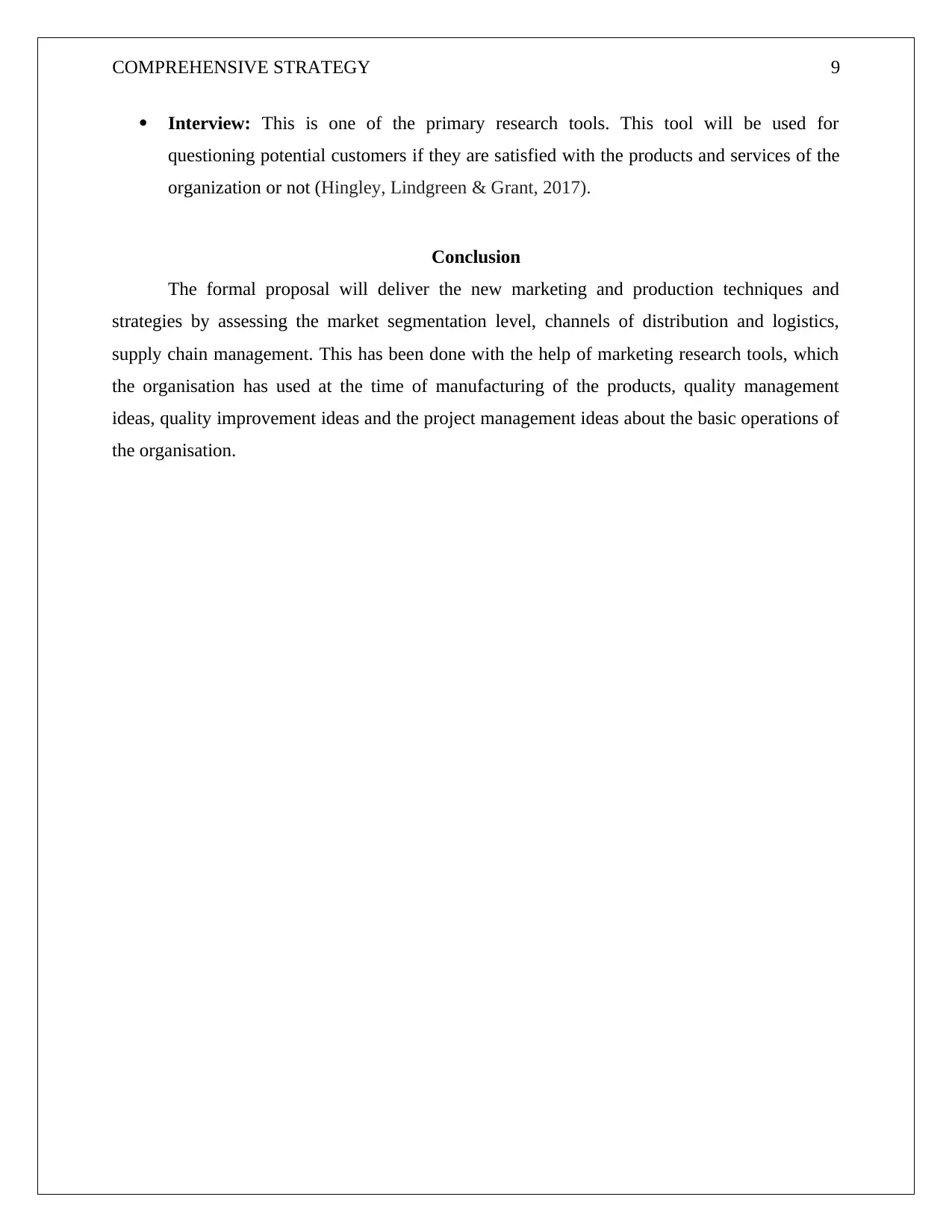
COMPREHENSIVE STRATEGY 9
Interview: This is one of the primary research tools. This tool will be used for
questioning potential customers if they are satisfied with the products and services of the
organization or not (Hingley, Lindgreen & Grant, 2017).
Conclusion
The formal proposal will deliver the new marketing and production techniques and
strategies by assessing the market segmentation level, channels of distribution and logistics,
supply chain management. This has been done with the help of marketing research tools, which
the organisation has used at the time of manufacturing of the products, quality management
ideas, quality improvement ideas and the project management ideas about the basic operations of
the organisation.
Interview: This is one of the primary research tools. This tool will be used for
questioning potential customers if they are satisfied with the products and services of the
organization or not (Hingley, Lindgreen & Grant, 2017).
Conclusion
The formal proposal will deliver the new marketing and production techniques and
strategies by assessing the market segmentation level, channels of distribution and logistics,
supply chain management. This has been done with the help of marketing research tools, which
the organisation has used at the time of manufacturing of the products, quality management
ideas, quality improvement ideas and the project management ideas about the basic operations of
the organisation.
Paraphrase This Document
Need a fresh take? Get an instant paraphrase of this document with our AI Paraphraser
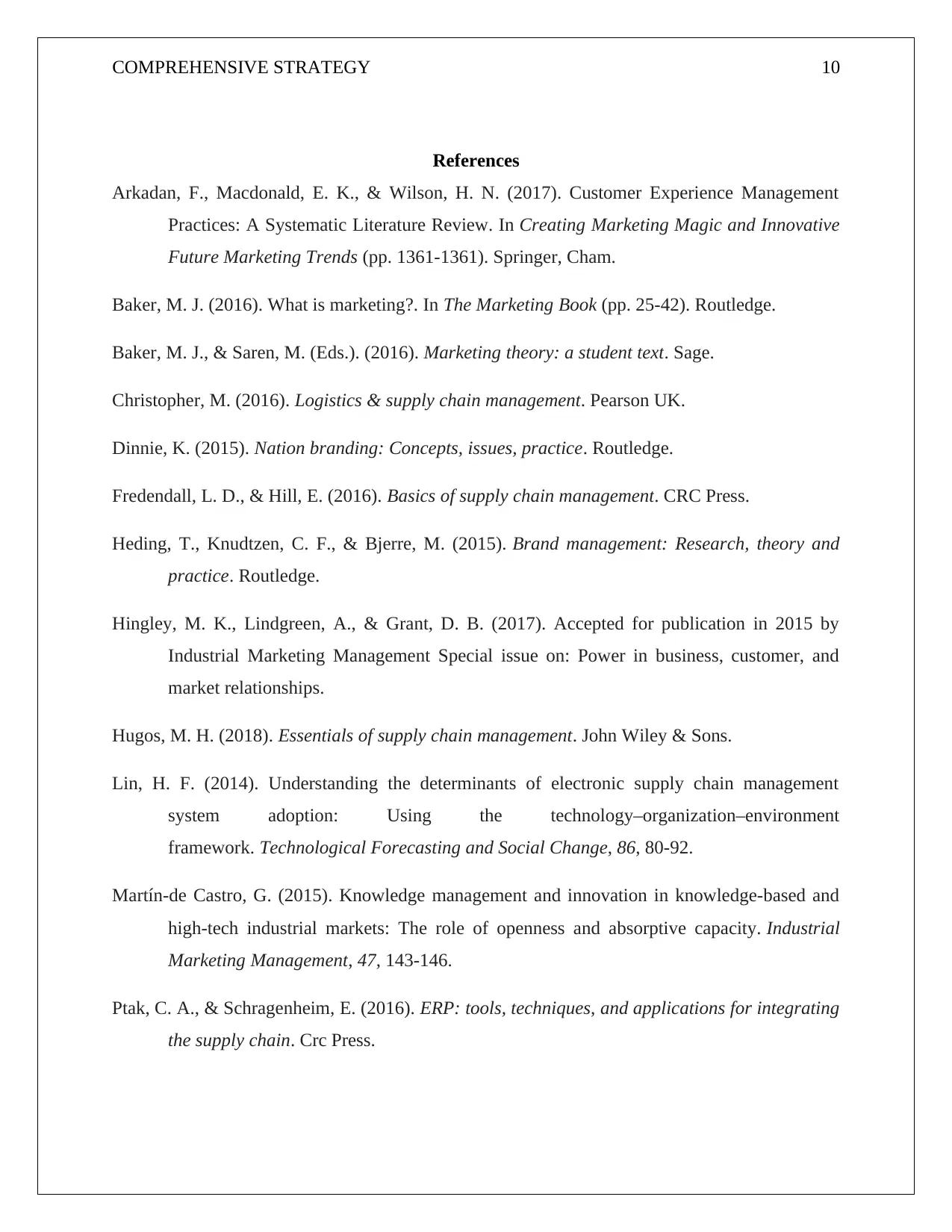
COMPREHENSIVE STRATEGY 10
References
Arkadan, F., Macdonald, E. K., & Wilson, H. N. (2017). Customer Experience Management
Practices: A Systematic Literature Review. In Creating Marketing Magic and Innovative
Future Marketing Trends (pp. 1361-1361). Springer, Cham.
Baker, M. J. (2016). What is marketing?. In The Marketing Book (pp. 25-42). Routledge.
Baker, M. J., & Saren, M. (Eds.). (2016). Marketing theory: a student text. Sage.
Christopher, M. (2016). Logistics & supply chain management. Pearson UK.
Dinnie, K. (2015). Nation branding: Concepts, issues, practice. Routledge.
Fredendall, L. D., & Hill, E. (2016). Basics of supply chain management. CRC Press.
Heding, T., Knudtzen, C. F., & Bjerre, M. (2015). Brand management: Research, theory and
practice. Routledge.
Hingley, M. K., Lindgreen, A., & Grant, D. B. (2017). Accepted for publication in 2015 by
Industrial Marketing Management Special issue on: Power in business, customer, and
market relationships.
Hugos, M. H. (2018). Essentials of supply chain management. John Wiley & Sons.
Lin, H. F. (2014). Understanding the determinants of electronic supply chain management
system adoption: Using the technology–organization–environment
framework. Technological Forecasting and Social Change, 86, 80-92.
Martín-de Castro, G. (2015). Knowledge management and innovation in knowledge-based and
high-tech industrial markets: The role of openness and absorptive capacity. Industrial
Marketing Management, 47, 143-146.
Ptak, C. A., & Schragenheim, E. (2016). ERP: tools, techniques, and applications for integrating
the supply chain. Crc Press.
References
Arkadan, F., Macdonald, E. K., & Wilson, H. N. (2017). Customer Experience Management
Practices: A Systematic Literature Review. In Creating Marketing Magic and Innovative
Future Marketing Trends (pp. 1361-1361). Springer, Cham.
Baker, M. J. (2016). What is marketing?. In The Marketing Book (pp. 25-42). Routledge.
Baker, M. J., & Saren, M. (Eds.). (2016). Marketing theory: a student text. Sage.
Christopher, M. (2016). Logistics & supply chain management. Pearson UK.
Dinnie, K. (2015). Nation branding: Concepts, issues, practice. Routledge.
Fredendall, L. D., & Hill, E. (2016). Basics of supply chain management. CRC Press.
Heding, T., Knudtzen, C. F., & Bjerre, M. (2015). Brand management: Research, theory and
practice. Routledge.
Hingley, M. K., Lindgreen, A., & Grant, D. B. (2017). Accepted for publication in 2015 by
Industrial Marketing Management Special issue on: Power in business, customer, and
market relationships.
Hugos, M. H. (2018). Essentials of supply chain management. John Wiley & Sons.
Lin, H. F. (2014). Understanding the determinants of electronic supply chain management
system adoption: Using the technology–organization–environment
framework. Technological Forecasting and Social Change, 86, 80-92.
Martín-de Castro, G. (2015). Knowledge management and innovation in knowledge-based and
high-tech industrial markets: The role of openness and absorptive capacity. Industrial
Marketing Management, 47, 143-146.
Ptak, C. A., & Schragenheim, E. (2016). ERP: tools, techniques, and applications for integrating
the supply chain. Crc Press.
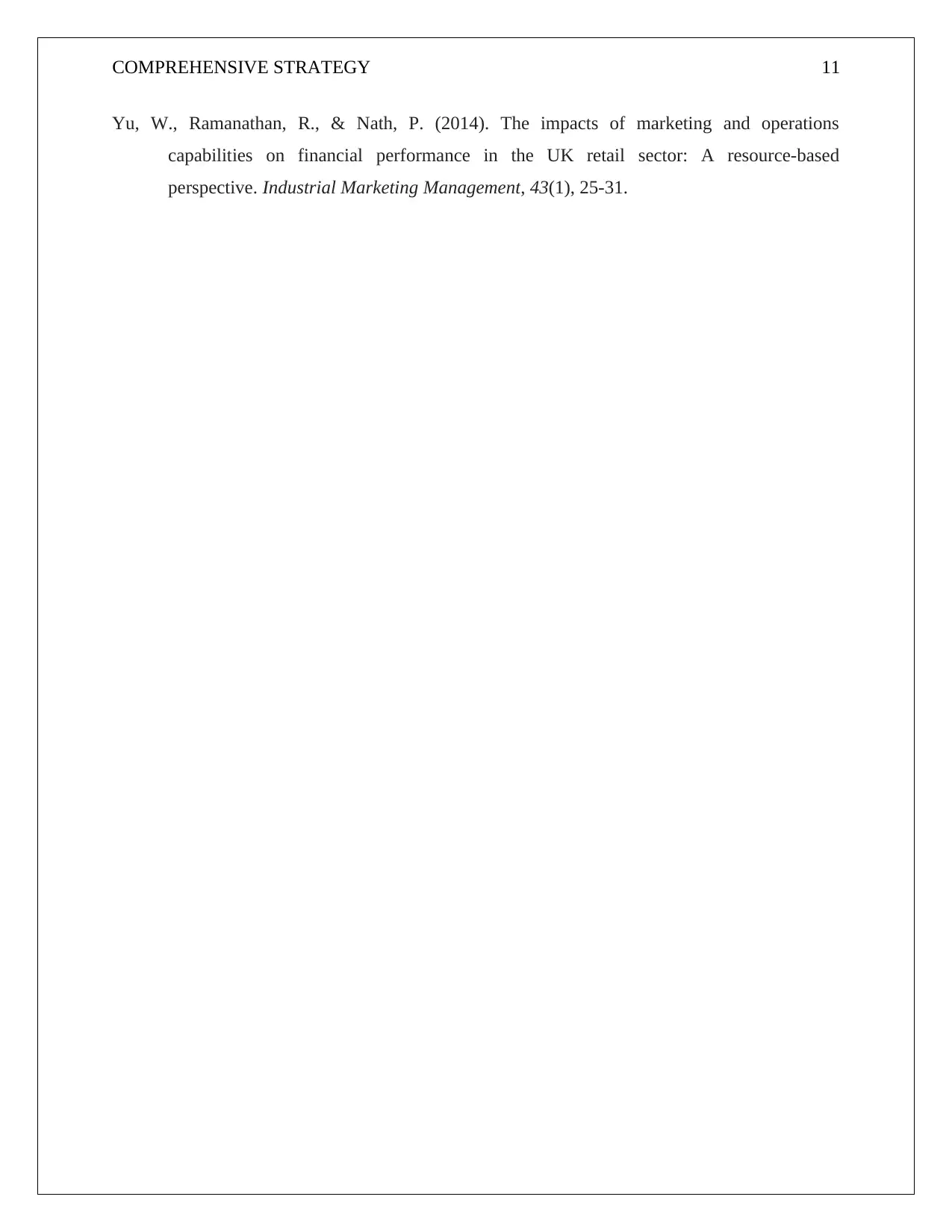
COMPREHENSIVE STRATEGY 11
Yu, W., Ramanathan, R., & Nath, P. (2014). The impacts of marketing and operations
capabilities on financial performance in the UK retail sector: A resource-based
perspective. Industrial Marketing Management, 43(1), 25-31.
Yu, W., Ramanathan, R., & Nath, P. (2014). The impacts of marketing and operations
capabilities on financial performance in the UK retail sector: A resource-based
perspective. Industrial Marketing Management, 43(1), 25-31.
⊘ This is a preview!⊘
Do you want full access?
Subscribe today to unlock all pages.

Trusted by 1+ million students worldwide
1 out of 12
Related Documents
Your All-in-One AI-Powered Toolkit for Academic Success.
+13062052269
info@desklib.com
Available 24*7 on WhatsApp / Email
![[object Object]](/_next/static/media/star-bottom.7253800d.svg)
Unlock your academic potential
Copyright © 2020–2025 A2Z Services. All Rights Reserved. Developed and managed by ZUCOL.





